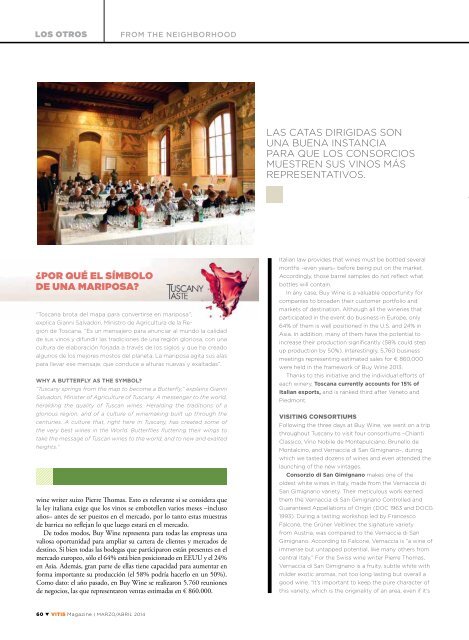rev_57
rev_57
rev_57
Create successful ePaper yourself
Turn your PDF publications into a flip-book with our unique Google optimized e-Paper software.
los otros<br />
FROM THE NEIGHBORHOOD<br />
Las catas dirigidas son<br />
una buena instancia<br />
para que los consorcios<br />
muestren sus vinos más<br />
representativos.<br />
¿Por qué el símbolo<br />
de una mariposa?<br />
“Toscana brota del mapa para convertirse en mariposa”,<br />
explica Gianni Salvadori, Ministro de Agricultura de la Región<br />
de Toscana. “Es un mensajero para anunciar al mundo la calidad<br />
de sus vinos y difundir las tradiciones de una región gloriosa, con una<br />
cultura de elaboración forjada a través de los siglos y que ha creado<br />
algunos de los mejores mostos del planeta. La mariposa agita sus alas<br />
para llevar ese mensaje, que conduce a alturas nuevas y exaltadas”.<br />
Why a butterfly as the symbol?<br />
“Tuscany springs from the map to become a Butterfly,” explains Gianni<br />
Salvadori, Minister of Agriculture of Tuscany. A messenger to the world,<br />
heralding the quality of Tuscan wines. Heralding the traditions of a<br />
glorious region, and of a culture of winemaking built up through the<br />
centuries. A culture that, right here in Tuscany, has created some of<br />
the very best wines in the World. Butterflies fluttering their wings to<br />
take the message of Tuscan wines to the world, and to new and exalted<br />
heights.”<br />
wine writer suizo Pierre Thomas. Esto es relevante si se considera que<br />
la ley italiana exige que los vinos se embotellen varios meses –incluso<br />
años– antes de ser puestos en el mercado, por lo tanto estas muestras<br />
de barrica no reflejan lo que luego estará en el mercado.<br />
De todos modos, Buy Wine representa para todas las empresas una<br />
valiosa oportunidad para ampliar su cartera de clientes y mercados de<br />
destino. Si bien todas las bodegas que participaron están presentes en el<br />
mercado europeo, sólo el 64% está bien posicionado en EEUU y el 24%<br />
en Asia. Además, gran parte de ellas tiene capacidad para aumentar en<br />
forma importante su producción (el 58% podría hacerlo en un 50%).<br />
Como dato: el año pasado, en Buy Wine se realizaron 5.760 reuniones<br />
de negocios, las que representaron ventas estimadas en € 860.000.<br />
Italian law provides that wines must be bottled several<br />
months –even years– before being put on the market.<br />
Accordingly, those barrel samples do not reflect what<br />
bottles will contain.<br />
In any case, Buy Wine is a valuable opportunity for<br />
companies to broaden their customer portfolio and<br />
markets of destination. Although all the wineries that<br />
participated in the event do business in Europe, only<br />
64% of them is well positioned in the U.S. and 24% in<br />
Asia. In addition, many of them have the potential to<br />
increase their production significantly (58% could step<br />
up production by 50%). Interestingly, 5,760 business<br />
meetings representing estimated sales for € 860,000<br />
were held in the framework of Buy Wine 2013.<br />
Thanks to this initiative and the individual efforts of<br />
each winery, Toscana currently accounts for 15% of<br />
Italian exports, and is ranked third after Veneto and<br />
Piedmont.<br />
VISITING CONSORTIUMS<br />
Following the three days at Buy Wine, we went on a trip<br />
throughout Tuscany to visit four consortiums –Chianti<br />
Classico, Vino Nobile de Montepulciano, Brunello de<br />
Montalcino, and Vernaccia di San Gimignano–, during<br />
which we tasted dozens of wines and even attended the<br />
launching of the new vintages.<br />
Consorzio di San Gimignano makes one of the<br />
oldest white wines in Italy, made from the Vernaccia di<br />
San Gimignano variety. Their meticulous work earned<br />
them the Vernaccia di San Gimignano Controlled and<br />
Guaranteed Appellations of Origin (DOC 1963 and DOCG<br />
1993). During a tasting workshop led by Francesco<br />
Falcone, the Grüner Veltliner, the signature variety<br />
from Austria, was compared to the Vernaccia di San<br />
Gimignano. According to Falcone, Vernaccia is “a wine of<br />
immense but untapped potential, like many others from<br />
central Italy.” For the Swiss wine writer Pierre Thomas,<br />
Vernaccia di San Gimignano is a fruity, subtle white with<br />
milder exotic aromas, not too long lasting but overall a<br />
good wine. “It’s important to keep the pure character of<br />
this variety, which is the originality of an area, even if it’s<br />
60 ▼ Vitis Magazine l marzo/abril 2014


